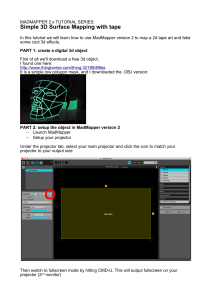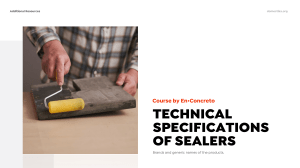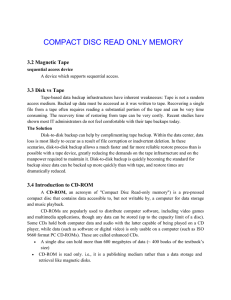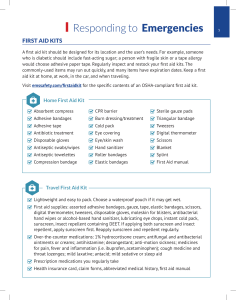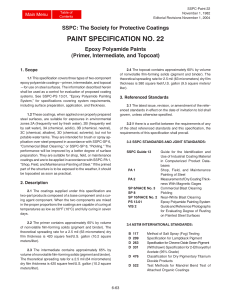ASTM D-3359 02 Standard test methods for measuring adhesion by tape test
Anuncio
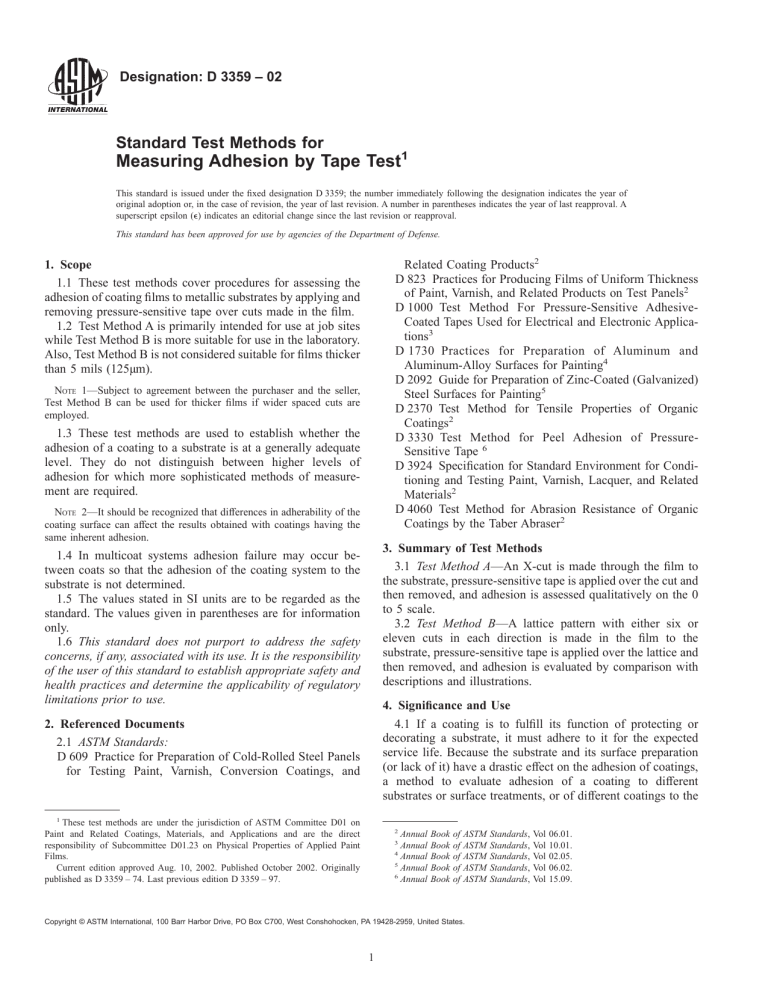
Designation: D 3359 – 02 Standard Test Methods for Measuring Adhesion by Tape Test1 This standard is issued under the fixed designation D 3359; the number immediately following the designation indicates the year of original adoption or, in the case of revision, the year of last revision. A number in parentheses indicates the year of last reapproval. A superscript epsilon (e) indicates an editorial change since the last revision or reapproval. This standard has been approved for use by agencies of the Department of Defense. Related Coating Products2 D 823 Practices for Producing Films of Uniform Thickness of Paint, Varnish, and Related Products on Test Panels2 D 1000 Test Method For Pressure-Sensitive AdhesiveCoated Tapes Used for Electrical and Electronic Applications3 D 1730 Practices for Preparation of Aluminum and Aluminum-Alloy Surfaces for Painting4 D 2092 Guide for Preparation of Zinc-Coated (Galvanized) Steel Surfaces for Painting5 D 2370 Test Method for Tensile Properties of Organic Coatings2 D 3330 Test Method for Peel Adhesion of PressureSensitive Tape 6 D 3924 Specification for Standard Environment for Conditioning and Testing Paint, Varnish, Lacquer, and Related Materials2 D 4060 Test Method for Abrasion Resistance of Organic Coatings by the Taber Abraser2 1. Scope 1.1 These test methods cover procedures for assessing the adhesion of coating films to metallic substrates by applying and removing pressure-sensitive tape over cuts made in the film. 1.2 Test Method A is primarily intended for use at job sites while Test Method B is more suitable for use in the laboratory. Also, Test Method B is not considered suitable for films thicker than 5 mils (125µm). NOTE 1—Subject to agreement between the purchaser and the seller, Test Method B can be used for thicker films if wider spaced cuts are employed. 1.3 These test methods are used to establish whether the adhesion of a coating to a substrate is at a generally adequate level. They do not distinguish between higher levels of adhesion for which more sophisticated methods of measurement are required. NOTE 2—It should be recognized that differences in adherability of the coating surface can affect the results obtained with coatings having the same inherent adhesion. 3. Summary of Test Methods 3.1 Test Method A—An X-cut is made through the film to the substrate, pressure-sensitive tape is applied over the cut and then removed, and adhesion is assessed qualitatively on the 0 to 5 scale. 3.2 Test Method B—A lattice pattern with either six or eleven cuts in each direction is made in the film to the substrate, pressure-sensitive tape is applied over the lattice and then removed, and adhesion is evaluated by comparison with descriptions and illustrations. 1.4 In multicoat systems adhesion failure may occur between coats so that the adhesion of the coating system to the substrate is not determined. 1.5 The values stated in SI units are to be regarded as the standard. The values given in parentheses are for information only. 1.6 This standard does not purport to address the safety concerns, if any, associated with its use. It is the responsibility of the user of this standard to establish appropriate safety and health practices and determine the applicability of regulatory limitations prior to use. 4. Significance and Use 4.1 If a coating is to fulfill its function of protecting or decorating a substrate, it must adhere to it for the expected service life. Because the substrate and its surface preparation (or lack of it) have a drastic effect on the adhesion of coatings, a method to evaluate adhesion of a coating to different substrates or surface treatments, or of different coatings to the 2. Referenced Documents 2.1 ASTM Standards: D 609 Practice for Preparation of Cold-Rolled Steel Panels for Testing Paint, Varnish, Conversion Coatings, and 1 These test methods are under the jurisdiction of ASTM Committee D01 on Paint and Related Coatings, Materials, and Applications and are the direct responsibility of Subcommittee D01.23 on Physical Properties of Applied Paint Films. Current edition approved Aug. 10, 2002. Published October 2002. Originally published as D 3359 – 74. Last previous edition D 3359 – 97. 2 Annual Annual 4 Annual 5 Annual 6 Annual 3 Book Book Book Book Book of of of of of ASTM ASTM ASTM ASTM ASTM Copyright © ASTM International, 100 Barr Harbor Drive, PO Box C700, West Conshohocken, PA 19428-2959, United States. 1 Standards, Standards, Standards, Standards, Standards, Vol Vol Vol Vol Vol 06.01. 10.01. 02.05. 06.02. 15.09. D 3359 – 02 clean and dry. Extremes in temperature or relative humidity may affect the adhesion of the tape or the coating. 7.1.1 For specimens which have been immersed: After immersion, clean and wipe the surface with an appropriate solvent which will not harm the integrity of the coating. Then dry or prepare the surface, or both, as agreed upon between the purchaser and the seller. 7.2 Make two cuts in the film each about 40 mm (1.5 in.) long that intersect near their middle with a smaller angle of between 30 and 45°. When making the incisions, use the straightedge and cut through the coating to the substrate in one steady motion. 7.3 Inspect the incisions for reflection of light from the metal substrate to establish that the coating film has been penetrated. If the substrate has not been reached make another X in a different location. Do not attempt to deepen a previous cut as this may affect adhesion along the incision. 7.4 Remove two complete laps of the pressure-sensitive tape from the roll and discard. Remove an additional length at a steady (that is, not jerked) rate and cut a piece about 75 mm (3 in.) long. 7.5 Place the center of the tape at the intersection of the cuts with the tape running in the same direction as the smaller angles. Smooth the tape into place by finger in the area of the incisions and then rub firmly with the eraser on the end of a pencil. The color under the transparent tape is a useful indication of when good contact has been made. 7.6 Within 90 6 30 s of application, remove the tape by seizing the free end and pulling it off rapidly (not jerked) back upon itself at as close to an angle of 180° as possible. 7.7 Inspect the X-cut area for removal of coating from the substrate or previous coating and rate the adhesion in accordance with the following scale: same substrate and treatment, is of considerable usefulness in the industry. 4.2 The limitations of all adhesion methods and the specific limitation of this test method to lower levels of adhesion (see 1.3) should be recognized before using it. The intra- and inter-laboratory precision of this test method is similar to other widely-accepted tests for coated substrates (for example, Test Method D 2370 and Test Method D 4060), but this is partly the result of it being insensitive to all but large differences in adhesion. The limited scale of 0 to 5 was selected deliberately to avoid a false impression of being sensitive. TEST METHOD A—X-CUT TAPE TEST 5. Apparatus and Materials 5.1 Cutting Tool—Sharp razor blade, scalpel, knife or other cutting devices. It is of particular importance that the cutting edges be in good condition. 5.2 Cutting Guide—Steel or other hard metal straightedge to ensure straight cuts. 5.3 Tape—25-mm (1.0-in.) wide semitransparent pressuresensitive tape7 with an adhesion strength agreed upon by the supplier and the user is needed. Because of the variability in adhesion strength from batch-to-batch and with time, it is essential that tape from the same batch be used when tests are to be run in different laboratories. If this is not possible the test method should be used only for ranking a series of test coatings. 5.4 Rubber Eraser, on the end of a pencil. 5.5 Illumination—A light source is helpful in determining whether the cuts have been made through the film to the substrate. 6. Test Specimens 6.1 When this test method is used in the field, the specimen is the coated structure or article on which the adhesion is to be evaluated. 6.2 For laboratory use apply the materials to be tested to panels of the composition and surface conditions on which it is desired to determine the adhesion. 5A 4A 3A 2A 1A 0A No peeling or removal, Trace peeling or removal along incisions or at their intersection, Jagged removal along incisions up to 1.6 mm (1⁄16 in.) on either side, Jagged removal along most of incisions up to 3.2 mm (1⁄8 in.) on either side, Removal from most of the area of the X under the tape, and Removal beyond the area of the X. 7.8 Repeat the test in two other locations on each test panel. For large structures make sufficient tests to ensure that the adhesion evaluation is representative of the whole surface. 7.9 After making several cuts examine the cutting edge and, if necessary, remove any flat spots or wire-edge by abrading lightly on a fine oil stone before using again. Discard cutting tools that develop nicks or other defects that tear the film. NOTE 3—Applicable test panel description and surface preparation methods are given in Practice D 609 and Practices D 1730 and D 2092. NOTE 4—Coatings should be applied in accordance with Practice D 823, or as agreed upon between the purchaser and the seller. NOTE 5—If desired or specified, the coated test panels may be subjected to a preliminary exposure such as water immersion, salt spray, or high humidity before conducting the tape test. The conditions and time of exposure will be governed by ultimate coating use or shall be agreed upon between the purchaser and seller. 8. Report 8.1 Report the number of tests, their mean and range, and for coating systems, where the failure occurred that is, between first coat and substrate, between first and second coat, etc. 8.2 For field tests report the structure or article tested, the location and the environmental conditions at the time of testing. 8.3 For test panels report the substrate employed, the type of coating, the method of cure, and the environmental conditions at the time of testing. 8.4 If the adhesion strength of the tape has been determined in accordance with Test Methods D 1000 or D 3330, report the 7. Procedure 7.1 Select an area free of blemishes and minor surface imperfections. For tests in the field, ensure that the surface is 7 Permacel 99, manufactured by Permacel, New Brunswick, NJ 08903, and available from various Permacel tape distributors, is reported to be suitable for this purpose. The manufacturer of this tape and the manufacturer of the tape used in the interlaboratory study (see RR: D01-1008), have advised this subcommittee that the properties of these tapes were changed. Users of it should, therefore, check whether current material gives comparable results to previous supplied material. 2 D 3359 – 02 12. Procedure results with the adhesion rating(s). If the adhesion strength of the tape has not been determined, report the specific tape used and its manufacturer. 8.5 If the test is performed after immersion, report immersion conditions and method of sample preparation. 12.1 Where required or when agreed upon, subject the specimens to a preliminary test before conducting the tape test (see Note 3). After drying or testing the coating, conduct the tape test at room temperature as defined in Specification D 3924, unless D 3924 standard temperature is required or agreed. 12.1.1 For specimens which have been immersed: After immersion, clean and wipe the surface with an appropriate solvent which will not harm the integrity of the coating. Then dry or prepare the surface, or both, as agreed upon between the purchaser and the seller. 12.2 Select an area free of blemishes and minor surface imperfections, place on a firm base, and under the illuminated magnifier, make parallel cuts as follows: 12.2.1 For coatings having a dry film thickness up to and including 2.0 mils (50 µm) space the cuts 1 mm apart and make eleven cuts unless otherwise agreed upon. 12.2.2 For coatings having a dry film thickness between 2.0 mils (50 µm) and 5 mils (125 µm), space the cuts 2 mm apart and make six cuts. For films thicker than 5 mils use Test Method A.11 12.2.3 Make all cuts about 20 mm (3⁄4 in.) long. Cut through the film to the substrate in one steady motion using just sufficient pressure on the cutting tool to have the cutting edge reach the substrate. When making successive single cuts with the aid of a guide, place the guide on the uncut area. 12.3 After making the required cuts brush the film lightly with a soft brush or tissue to remove any detached flakes or ribbons of coatings. 12.4 Examine the cutting edge and, if necessary, remove any flat spots or wire-edge by abrading lightly on a fine oil stone. Make the additional number of cuts at 90° to and centered on the original cuts. 12.5 Brush the area as before and inspect the incisions for reflection of light from the substrate. If the metal has not been reached make another grid in a different location. 12.6 Remove two complete laps of tape and discard. Remove an additional length at a steady (that is, not jerked) rate and cut a piece about 75 mm (3 in.) long. 12.7 Place the center of the tape over the grid and in the area of the grid smooth into place by a finger. To ensure good contact with the film rub the tape firmly with the eraser on the end of a pencil. The color under the tape is a useful indication of when good contact has been made. 12.8 Within 90 6 30 s of application, remove the tape by seizing the free end and rapidly (not jerked) back upon itself at as close to an angle of 180° as possible. 12.9 Inspect the grid area for removal of coating from the substrate or from a previous coating using the illuminated magnifier. Rate the adhesion in accordance with the following scale illustrated in Fig. 1: 9. Precision and Bias 8 9.1 In an interlaboratory study of this test method in which operators in six laboratories made one adhesion measurement on three panels each of three coatings covering a wide range of adhesion, the within-laboratories standard deviation was found to be 0.33 and the between-laboratories 0.44. Based on these standard deviations, the following criteria should be used for judging the acceptability of results at the 95 % confidence level: 9.1.1 Repeatability—Provided adhesion is uniform over a large surface, results obtained by the same operator should be considered suspect if they differ by more than 1 rating unit for two measurements. 9.1.2 Reproducibility—Two results, each the mean of triplicates, obtained by different operators should be considered suspect if they differ by more than 1.5 rating units. 9.2 Bias cannot be established for these test methods. TEST METHOD B—CROSS-CUT TAPE TEST 10. Apparatus and Materials 10.1 Cutting Tool9—Sharp razor blade, scalpel, knife or other cutting device having a cutting edge angle between 15 and 30° that will make either a single cut or several cuts at once. It is of particular importance that the cutting edge or edges be in good condition. 10.2 Cutting Guide—If cuts are made manually (as opposed to a mechanical apparatus) a steel or other hard metal straightedge or template to ensure straight cuts. 10.3 Rule—Tempered steel rule graduated in 0.5 mm for measuring individual cuts. 10.4 Tape, as described in 5.3. 10.5 Rubber Eraser, on the end of a pencil. 10.6 Illumination, as described in 5.5. 10.7 Magnifying Glass—An illuminated magnifier to be used while making individual cuts and examining the test area. 11. Test Specimens 11.1 Test specimens shall be as described in Section 6. It should be noted, however, that multitip cutters10 provide good results only on test areas sufficiently plane that all cutting edges contact the substrate to the same degree. Check for flatness with a straight edge such as that of the tempered steel rule (10.3). 8 Supporting data are available from ASTM International Headquarters. Request RR: D01–1008. 9 Multiblade cutters are available from a few sources that specialize in testing equipment for the paint industry. One supplier that has assisted in the refinement of these methods is given in footnote 10. 10 The sole source of supply of the multitip cutter for coated pipe surfaces known to the committee at this time is Paul N. Gardner Co., 316 NE First St., Pompano Beach, FL 33060. If you are aware of alternative suppliers, please provide this information to ASTM International Headquarters. Your comments will receive careful consideration at a meeting of the responsible technical committee,1 which you may attend. 11 Test Method B has been used successfully by some people on coatings greater than 5 mils (0.13 mm) by spacing the cuts 5 mm apart. However, the precision values given in 14.1 do not apply as they are based on coatings less than 5 mm (0.13 mm) in thickness. 3 D 3359 – 02 5B 4B 3B 2B 1B 0B The edges of the cuts are completely smooth; none of the squares of the lattice is detached. Small flakes of the coating are detached at intersections; less than 5 % of the area is affected. Small flakes of the coating are detached along edges and at intersections of cuts. The area affected is 5 to 15 % of the lattice. The coating has flaked along the edges and on parts of the squares. The area affected is 15 to 35 % of the lattice. The coating has flaked along the edges of cuts in large ribbons and whole squares have detached. The area affected is 35 to 65 % of the lattice. Flaking and detachment worse than Grade 1. 12.10 Repeat the test in two other locations on each test panel. 13. Report 13.1 Report the number of tests, their mean and range, and for coating systems, where the failure occurred, that is, between first coat and substrate, between first and second coat, etc. 13.2 Report the substrate employed, the type of coating and the method of cure. 13.3 If the adhesion strength has been determined in accordance with Test Methods D 1000 or D 3330, report the results with the adhesion rating(s). If the adhesion strength of the tape has not been determined, report the specific tape used and its manufacturer. 13.4 If the test is performed after immersion, report immersion conditions and method of sample preparation. 14. Precision and Bias 8 14.1 On the basis of two interlaboratory tests of this test method in one of which operators in six laboratories made one adhesion measurement on three panels each of three coatings covering a wide range of adhesion and in the other operators in six laboratories made three measurements on two panels each of four different coatings applied over two other coatings, the pooled standard deviations for within- and betweenlaboratories were found to be 0.37 and 0.7. Based on these standard deviations, the following criteria should be used for judging the acceptability of results at the 95 % confidence level: 14.1.1 Repeatability—Provided adhesion is uniform over a large surface, results obtained by the same operator should be considered suspect if they differ by more than one rating unit for two measurements. FIG. 1 Classification of Adhesion Test Results 14.1.2 Reproducibility—Two results, each the mean of duplicates or triplicates, obtained by different operators should be considered suspect if they differ by more than two rating units. 14.2 Bias cannot be established for these test methods. 15. Keywords 15.1 adhesion; crosscut adhesion test method; tape; tape adhesion test method; X-cut adhesion test method 4 D 3359 – 02 APPENDIX (Nonmandatory Information) X1. COMMENTARY X1.1 Introduction X1.1.1 Given the complexities of the adhesion process, can adhesion be measured? As Mittal (1)12 has pointed out, the answer is both yes and no. It is reasonable to state that at the present time no test exists that can precisely assess the actual physical strength of an adhesive bond. But it can also be said that it is possible to obtain an indication of relative adhesion performance. X1.1.2 Practical adhesion test methods are generally of two types: “implied” and “direct.” “Implied” tests include indentation or scribe techniques, rub testing, and wear testing. Criticism of these tests arises when they are used to quantify the strength of adhesive bonding. But this, in fact, is not their purpose. An “implied” test should be used to assess coating performance under actual service conditions. “Direct” measurements, on the other hand, are intended expressly to measure adhesion. Meaningful tests of this type are highly sought after, primarily because the results are expressed by a single discrete quantity, the force required to rupture the coating/substrate bond under prescribed conditions. Direct tests include the Hesiometer and the Adherometer (2). Common methods which approach the direct tests are peel, lapshear, and tensile tests. of film removal observed when the tape is pulled off. Since an intact film with appreciable adhesion is frequently not removed at all, the severity of the test is usually enhanced by cutting into the film a figure X or a cross hatched pattern, before applying and removing the tape. Adhesion is then rated by comparing film removed against an established rating scale. If an intact film is peeled cleanly by the tape, or if it debonds just by cutting into it without applying tape, then the adhesion is rated simply as poor or very poor, a more precise evaluation of such films not being within the capability of this test. X1.3.2 The current widely-used version was first published in 1974; two test methods are covered in this standard. Both test methods are used to establish whether the adhesion of a coating to a substrate is at an adequate level; however they do not distinguish between higher levels of adhesion for which more sophisticated methods of measurement are required. Major limitations of the tape test are its low sensitivity, applicability only to coatings of relatively low bond strengths, and non-determination of adhesion to the substrate where failure occurs within a single coat, as when testing primers alone, or within or between coats in multicoat systems. For multicoat systems where adhesion failure may occur between or within coats, the adhesion of the coating system to the substrate is not determined. X1.3.3 Repeatability within one rating unit is generally observed for coatings on metals for both methods, with reproducibility of one to two units. The tape test enjoys widespread popularity and is viewed as “simple” as well as low in cost. Applied to metals, it is economical to perform, lends itself to job site application, and most importantly, after decades of use, people feel comfortable with it. X1.3.4 When a flexible adhesive tape is applied to a coated rigid substrate surface and then removed, the removal process has been described in terms of the “peel phenomenon,” as illustrated in Fig. X1.1. X1.3.5 Peeling begins at the “toothed” leading edge (at the right) and proceeds along the coating adhesive/interface or the coating/substrate interface, depending on the relative bond strengths. It is assumed that coating removal occurs when the tensile force generated along the latter interface, which is a function of the rheological properties of the backing and adhesive layer materials, is greater than the bond strength at the coating-substrate interface (or cohesive strength of the coating). In actuality, however, this force is distributed over a discrete distance (O-A) in Fig. X1.1, which relates directly to the properties described, not concentrated at a point (O) in Fig. X1.1 as in the theoretical case—though the tensile force is greatest at the origin for both. A significant compressive force arises from the response of the tape backing material to being stretched. Thus both tensile and compressive forces are involved in adhesion tape testing. X1.3.6 Close scrutiny of the tape test with respect to the X1.2 Test Methods X1.2.1 In practice, numerous types of tests have been used to attempt to evaluate adhesion by inducing bond rupture by different modes. Criteria deemed essential for a test to warrant large-scale acceptance are: use of a straightforward and unambiguous procedure; relevance to its intended application; repeatability and reproducibility; and quantifiability, including a meaningful rating scale for assessing performance. X1.2.2 Test methods used for coatings on metals are: peel adhesion or “tape testing;” Gardner impact flexibility testing; and adhesive joint testing including shear (lap joint) and direct tensile (butt joint) testing. These tests do not strictly meet all the criteria listed, but an appealing aspect of these tests is that in most cases the equipment/instrumentation is readily available or can be obtained at reasonable cost. X1.2.3 A wide diversity of tests methods have been developed over the years that measure aspects of adhesion (1-5). There generally is difficulty, however, in relating these tests to basic adhesion phenomena. X1.3 The Tape Test X1.3.1 By far the most prevalent test for evaluating coating “adhesion” is the tape-and-peel test, which has been used since the 1930’s. In its simplest version a piece of adhesive tape is pressed against the paint film and the resistance to and degree 12 The boldface numbers in parentheses refer to the list of references at the end of this test method. 5 D 3359 – 02 interference/radio frequency interference (EMI/RFI) coatings, it was found that, while peel was indeed consistent for a given coating, the value varied by 25 % between the highest and lowest ratings among coatings. Several factors that contribute to these differences include coating composition and topology: as a result, no single tape is likely to be suitable for testing all coatings. Further, the tape test does not give an absolute value for the force required for bond rupture, but serves only as an indicator that some minimum value for bond strength was met or exceeded (7, 8). X1.6 Procedural Problems X1.6.1 The tape test is operator intensive. By design it was made as simple as possible to perform, and requires a minimum of specialized equipment and materials that must meet certain specifications. The accuracy and precision depend largely upon the skill of the operator and the operator’s ability to perform the test in a consistent manner. Key steps that directly reflect the importance of operator skill include the angle and rate of tape removal and the visual assessment of the tested sample. It is not unexpected that different operators might obtain different results (7, 8). X1.6.2 Peel Angle and Rate: The standard requires that the free end of the tape be removed rapidly at as close to a 180° angle as possible. If the peel angle and rate vary, the force required to remove the tape can change dramatically. Nearly linear increases were observed in peel force approaching 100 % as peel angle was changed from 135 to 180, and similar large differences can be expected in peel force as peel rate varies. These effects are related as they reflect certain rheological properties of the backing and adhesive that are molecular in origin. Variation in pull rate and peel angle can effect large differences in test values and must be minimized to assure reproducibility (9). X1.6.3 Visual Assessment: The final step in the test is visual assessment of the coating removed from the specimen, which is subjective in nature, so that the coatings can vary among individuals evaluating the same specimen (9). X1.6.3.1 Performance in the tape test is based on the amount of coating removed compared to a descriptive scale. The exposure of the substrate can be due to factors other than coating adhesion, including that arising from the requirement that the coating be cut (hence the synonym“ cross-hatch adhesion test”). Justification for the cutting step is reasonable as cutting provides a free edge from which peeling can begin without having to overcome the cohesive strength of the coating layer. X1.6.3.2 Cutting might be suitable for coatings applied to metal substrates, but for coatings applied to plastics or wood, the process can lead to a misleading indication of poor adhesion due to the unique interfacial zone. For coatings on soft substrates, issues include how deep should this cut penetrate, and is it possible to cut only to the interface? X1.6.3.3 In general, if adhesion test panels are examined microscopically, it is often clearly evident that the coating removal results from substrate failure at or below the interface, and not from the adhesive failure between the coating and the substrate. Cohesive failure within the coating film is also FIG. X1.1 Peel Profile (6) nature of the tape employed and certain aspects of the procedure itself reveal several factors, each or any combination of which can dramatically affect the results of the test as discussed (6). X1.4 Peel Adhesion Testing on Plastic Substrates X1.4.1 Tape tests have been criticized when used for substrates other than metal, such as plastics. The central issues are that the test on plastics lacks reproducibility and does not relate to the intended application. Both concerns are well founded: poor precision is a direct result of several factors intrinsic to the materials employed and the procedure itself. More importantly, in this instance the test is being applied beyond its intended scope. These test methods were designed for relatively ductile coatings applied to metal substrates, not for coatings (often brittle) applied to plastic parts (7). The unique functional requirements of coatings on plastic substrates cause the usual tape tests to be unsatisfactory for measuring adhesion performance in practice. X1.5 The Tape Controversy X1.5.1 With the withdrawal from commerce of the tape specified originally, 3M No. 710, current test methods no longer identify a specific tape. Differences in tapes used can lead to different results as small changes in backing stiffness and adhesive rheology cause large changes in the tension area. Some commercial tapes are manufactured to meet minimum standards. A given lot may surpass these standards and thus be suitable for general market distribution; however, such a lot may be a source of serious and unexpected error in assessing adhesion. One commercially available tape test kit had included a tape with adhesion strength variations of up to 50 % claimed by the manufacturer. Also, because tapes change on storage, bond strengths of the tape may change over time (7, 8). X1.5.2 While there are tapes available that appear to deliver consistent performance, a given tape does not adhere equally well to all coatings. For example, when the peel removal force of the tape (from the coating) used earlier by Task Group D01.23.10 to establish precision of the method, by 3M No. 710 was examined with seven different electromagnetic 6 D 3359 – 02 frequently observed. However, with the tape test, failures within the substrate or coating layers are rare because the tape adhesive is not usually strong enough to exceed the cohesive strengths of normal substrates and organic coatings. Although some rather brittle coatings may exhibit cohesive failure, the tape test adhesion method does not make provision for giving failure locality (7, 8). X1.6.4 Use of the test method in the field can lead to variation in test results due to temperature and humidity changes and their effect upon tape, coating and substrate. X1.7 Conclusion X1.7.1 All the issues aside, if these test methods are used within the Scope Section and are performed carefully, some insight into the approximate, relative level of adhesion can be gained. REFERENCES (1) Mittal, K. L., “Adhesion Measurement: Recent Progress, Unsolved Problems, and Prospects”, “Adhesion Measurement of Thin Films, Thick Films, and Bulk Coatings,” ASTM STP 640, ASTM, 1978, pp. 7–8. (2) Corcoron, E. M., “Adhesion,” Chapter 5.3, Paint Testing Manual, 13th ed., ASTM STP 500, ASTM, 1972, pp. 314–332. (3) Gardner, H. A., and Sward, G. G., Paint Testing Manual, 12th ed., Chapter 7, Gardner Laboratory, Bethesda, MD, 1962, pp. 159–170. (4) Mittal, K. L., Journal of Adhesion Science and Technology, Vol 1, No. 3, 1987, pp. 247–259. (5) Stoffer, J. O., and Gadodia, S. K., American Paint and Coatings Journal, Vol 70, Nos. 50 and 51, 1991, pp. 36–40 and 36–51, respectively. (6) Souheng, Wu, Polymer Interface and Adhesion, Marcel Dekker, Inc., New York, NY, 1982, p. 531. (7) Nelson, G. L., Gray, K. N., and Buckley, S. E., Modern Paint and Coatings, Vol 75, No. 10, 1985, pp. 160–172. (8) Nelson, G. L., and Gray, K. N., “Coating Adhesion to Plastics,” Proceedings, Waterborne and Higher Solids Coatings Symposium, Vol 13, New Orleans, LA, February 5–7, 1986, pp. 114–131. (9) K. L. Mittal, ed., “Symposium on Adhesion Aspects of Polymeric Coatings,” Proceedings, The Electrochemical Society, 1981, pp. 569–582. SUMMARY OF CHANGES Committee D01 has identified the location of selected changes to this standard since the last issue (D 3359 - 97) that may impact the use of this standard. (1) Deleted reference to Test Method D 2197 in Referenced Documents section and editorially changed footnote 10 to avoid confusion with another adhesion test method. (2) Added 7.1.1, 8.5, 12.1.1, and 13.4 to clarify use when testing samples that have been immersed. ASTM International takes no position respecting the validity of any patent rights asserted in connection with any item mentioned in this standard. Users of this standard are expressly advised that determination of the validity of any such patent rights, and the risk of infringement of such rights, are entirely their own responsibility. This standard is subject to revision at any time by the responsible technical committee and must be reviewed every five years and if not revised, either reapproved or withdrawn. Your comments are invited either for revision of this standard or for additional standards and should be addressed to ASTM International Headquarters. Your comments will receive careful consideration at a meeting of the responsible technical committee, which you may attend. If you feel that your comments have not received a fair hearing you should make your views known to the ASTM Committee on Standards, at the address shown below. This standard is copyrighted by ASTM International, 100 Barr Harbor Drive, PO Box C700, West Conshohocken, PA 19428-2959, United States. Individual reprints (single or multiple copies) of this standard may be obtained by contacting ASTM at the above address or at 610-832-9585 (phone), 610-832-9555 (fax), or service@astm.org (e-mail); or through the ASTM website (www.astm.org). 7

